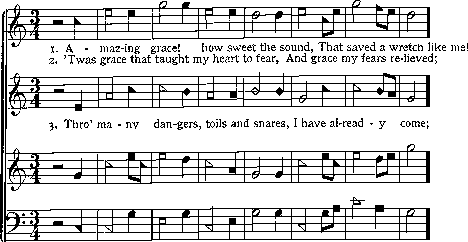Shape-Note
Quick Contents:
Shape note introduction,
notation example,
other books,
Boston area open sings,
Sacred Harp singing conventions,
other WWW shape-note servers,
shape-note resources and Internet mailing list.
Shape-note tunebooks, of which the
Original Sacred Harp
is a later example,
are a development of the New England singing schools and their use
of the fa-sol-la (hence Fasola) solmization
to teach part-music to otherwise
musically untrained folk.
A more
detailed history
of the development of shapenote tunebooks is under development.
The notation makes use of different shapes of note-heads to indicate
the seven degrees of the scale. While there are avid singers from
seven-shape books, most of the books I use rely on four shapes:
Fa  ,
Sol
,
Sol  ,
La
,
La  ,
and Mi
,
and Mi  which is the leading tone.
These can represent a Major scale as fa-sol-la fa-sol-la mi fa;
where fa is used
both for the tonic (I) and the subdominant (IV) degrees of the scale.
There are whole steps between fa, sol, and la; the note below fa
is a half-step down; the tonic is a half-step above mi. By reading the
shapes one need not be too concerned about the sharps and flats in the
key signature and how to decipher where the half and whole steps lie
on the staff.
which is the leading tone.
These can represent a Major scale as fa-sol-la fa-sol-la mi fa;
where fa is used
both for the tonic (I) and the subdominant (IV) degrees of the scale.
There are whole steps between fa, sol, and la; the note below fa
is a half-step down; the tonic is a half-step above mi. By reading the
shapes one need not be too concerned about the sharps and flats in the
key signature and how to decipher where the half and whole steps lie
on the staff.
It is traditional, and still practiced, that people who gather together
to sing this music first "sing the notes", that is,
singing the fa-sol-la syllables from the notation, which sets the tune
in memory for then singing it complete with the words.
Those who do not yet know the shapes can merely read the printed music
as written,
ignoring the extra information contained in the shape of the noteheads,
as this excerpt from the
Original Sacred Harp
shows below:
from the Original Sacred Harp

The familiar melody is found in the Tenor line.
Additional shape-note tunebooks are Northern Harmony featuring
works of traditional New England composers,
The Norumbega Harmony Sampler, a preview
of our forthcoming tunebook;
The Sacred Harper's Companion
devoted to work of contemporary composers in the traditional style;
and
Northampton Harmony, containing both old and new works.
Persons in the Boston area desiring to acquaint themselves with
this sort of music can attend the monthly open sings sponsored by
Norumbega Harmony
every second Monday of the month starting at 7:45 PM - see
flyer for dates, location, and contact info.
Throughout the year, in various areas, there are conventions where
folk travel to join together in song, a hundred voices per part at times.
More information on the New England and other area
Sacred Harp Singing Conventions
is available here.
Keith Willard at the University of Minnesota has put up a set of
Fasola pages
that include access to the Resources list mentioned below,
archives of the fasola mailing list,
and many other items of interest to the shape-note singing community.
See also
Warren Steel's Sacred Harp page.
Dr. Steel has been singing and studying this music for many years and
is a contributor to the 1991 Denson revision of The Sacred Harp.
West Gallery Music
is the English analog to the New England Singing School tunes of the
late 18th century.
A directory of recordings, tunebooks, and other information
about shape-note singing is available as the
Sacred Harp and Shape-Note Resource Guide
For those who want to keep up to date with the shape-note singing
community online,
there is a shape-note mailing list and archive server;
information available at
fasola.org
Corrections, additions or comments?
Send email
(if supported by your browser) to the author, ijs@mit.edu.
Original mid 1994
Last Modified: Mar 4 09:39 EST 2003 /
Ishmael the Fiddler
![]() ,
Sol
,
Sol ![]() ,
La
,
La ,
and Mi
which is the leading tone.
These can represent a Major scale as fa-sol-la fa-sol-la mi fa;
where fa is used
both for the tonic (I) and the subdominant (IV) degrees of the scale.
There are whole steps between fa, sol, and la; the note below fa
is a half-step down; the tonic is a half-step above mi. By reading the
shapes one need not be too concerned about the sharps and flats in the
key signature and how to decipher where the half and whole steps lie
on the staff.
